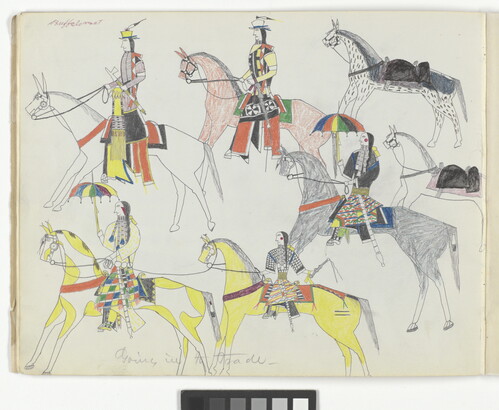


Artwork Images
Photo:
Controls
Going in to Trade
Object Details
-
Date
1876
-
Object Type
Drawings
-
Medium
Colored pencil, graphite, and ink on paper
-
Object Format
Book
-
Dimensions
8 3/4 x 11 1/4 in.
-
Inscriptions
Recto:
u.l. inscribed in red pencil: Buffalo Meat
l.c. in graphite: Going in to Trade-
-
Credit Line
Amon Carter Museum of American Art, Fort Worth, Texas
-
Accession Number
1965.48.7
-
Copyright
Public domain
Object Description
In 1875 Buffalo Meat, a young Southern Cheyenne man, was arrested and transferred to Fort Marion in St. Augustine, Florida, where he was imprisoned alongside roughly 40 Arapaho, Cheyenne, Comanche, Kiowa, and other Native Americans who had been detained following altercations with army soldiers in Oklahoma Territory. At the fort, Buffalo Meat and his fellow prisoners were encouraged to make autobiographical drawings on sheets of repurposed ledger paper. This experimental project was initiated by prison commander Captain Richard Henry Pratt, an early proponent of off-reservation boarding schools, a coercive educational system that attempted to assimilate Indigenous peoples into White society and culture.
Buffalo Meat and his companions produced scores of drawings at Fort Marion, many of which they sold to curious visitors. Although created in repressive conditions, ledger drawings afforded a space for imprisoned men to portray scenes that asserted their status within their own communities—a form of cultural self-preservation that resisted Pratt’s assimilationist aims.
—Text taken from the Carter Handbook (2023).
Additional details
Location: Off view
See more by Buffalo Meat
Tags
-
Grades 4–8
Who Paints Your Story? Indigenous Depictions in Art (monthly special; available year-round by request)
Take a closer look at depictions of Indigenous communities in American art and introduce students to contemporary Indigenous artists from the Carter collection. Students will examine icons and stereotypes, the importance of representation, and the reclamation of culture.
Learn more and register by visiting Connect2Texas and filter for “Amon Carter Museum of American Art.” If you have questions, contact us by email or call 817.989.5011.
Share Educator Resources
Amon Carter Disclaimer
This information is published from the Carter's collection database. Updates and additions based on research and imaging activities are ongoing. The images, titles, and inscriptions are products of their time and are presented here as documentation, not as a reflection of the Carter’s values. If you have corrections or additional information about this object please email us to help us improve our records.
Every effort has been made to accurately determine the rights status of works and their images. Please email us if you have further information on the rights status of a work contrary or in addition to the information in our records.
Related Works
-
Kicking Bear--Sioux, 1971
Leonard Baskin
Ink and ink wash on paper
1971.12
-
Study for "Symphony in Flesh Color and Pink: Portrait of Mrs. Frances Leyland", 1871-1874
James McNeill Whistler
Pastel and charcoal on paper
1990.9
-
Ca-Ta-He-Cas-Sa-Black Hoof, Principal Chief of the Shawanoes, 1872-1874
Unknown
Lithograph with applied watercolor
2004.19.40
-
Naw-Kaw, a Winnebago Chief, 1872-1874
James Otto Lewis
Lithograph with applied watercolor
2004.19.39
-
Payta-Kootha, a Shawanoe Warrior, 1872-1874
Charles Bird King
Lithograph with applied watercolor
2004.19.29
-
Se-Quo-Yah, 1872-1874
Charles Bird King
Lithograph with applied watercolor
2004.19.5
-
Chief Gall, 1971
Leonard Baskin
Ink and ink wash on paper
1971.5
-
Mistippee, 1872-1874
Charles Bird King
Lithograph with applied watercolor
2004.19.8
-
Sitting Bull, 1971
Leonard Baskin
Ink and ink wash on paper
1971.10


